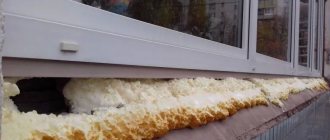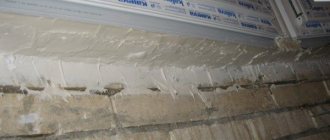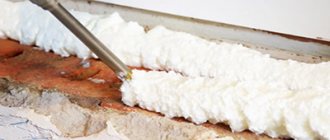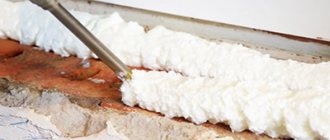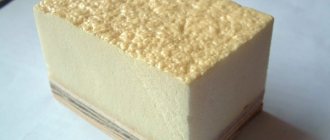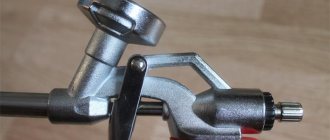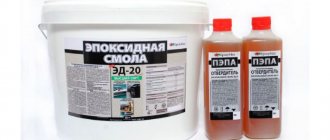The use of polyurethane foam is increasing significantly, as it is an excellent sealant for the repair and installation of windows and doorways. Its rapid adhesion to all surfaces has a negative side when cleaning from contaminants. Cleaning foam is not that easy. Each surface has its own characteristics, so all factors are taken into account before cleaning.
Doors and windows
The polyurethane composition includes catalysts and stabilizers, which are responsible for the consumption and foaming of the material. After the expiration of the specified excess balances are very difficult. There are effective ways to clean polyurethane foam without damaging the area being treated.
Basic means for cleaning polyurethane foam from the surface of a door or window opening:
- Acetone and a liquid based on it effectively dissolve the polyurethane mixture, but will leave marks on the varnished surface.
- To remove fresh composition, cleaning agents ULTIMA and PENOSIL are suitable, which effectively remove the applied sealant.
- Professional products Penosil-Premium, Cosmofen, Isofoam R621 are used to remove hardened residues from plastic.
Pharmacies sell the drug Dimexide, which has good dissolving properties. Dimexide removes hardened composition from any surfaces, gradually destroying the foam structure.
Important: When using Dimexide, you must wear gloves, as there is a risk of burns. Complete cleaning of the hardened polyurethane foam occurs within 24 hours.
PVC material
Polyurethane sealant is most often used to insulate plastic windows, so excess insulation remains on the surface of the glass unit, frame, and window sill. When applied very carefully on the surface of a plastic window in the area of the gaps, the mass hardens into unsightly drops, which can be cleaned in the following way:
- The visible part of the composition is carefully trimmed with a knife and removed.
- Apply a little vegetable oil to the resulting stain.
3. To clean foam from plastic windows, allow the oil to soak in for 15 minutes.
After softening, the marks can be easily washed off with a dish sponge. It is not recommended to use chemical reagents to avoid damaging the plastic. The oil will be washed off from the PVC with any detergent.
Another option is to use pharmacy Dimexide. To clean polyurethane foam from plastic windows, balconies, doors, an inexpensive gel is applied to the stain (always wearing gloves) and evenly distributed with a brush. After a few minutes, you need to wipe the cleaned area with a damp cloth.
Attention: Plastic does not interact well with solvents and strong reagents. There will be stains on the surface of the window or door panel.
Wooden structures
Polyurethane sealant is used to seal gaps in wooden windows and doors. To protect wood from moisture and the formation of fungus and mold, it is coated with paint and varnish. Using the folk method, you can wipe off the foam from a wooden door or window frame. To do this, you need to dissolve a spoonful of salt in a glass of plain water. You need to treat the contaminated area with the prepared mixture, and then wipe off the foam from the door with a sponge.
To make the foam wipe off easily, you can leave the saline solution for a few minutes. After this, rinse off the product - no stains remain on the varnished or painted wood. Salt will remove foam from the door leaf in a few minutes, and using a scraper may leave small scratches.
Parquet and parquet boards
Floor coverings made of parquet and parquet boards are painted and varnished to protect against moisture and highlight the structure of the wood. Aggressive chemical components corrode the varnish if used on a parquet floor. To better remove stains, complete polymerization must be prevented. As soon as the polyurethane dries slightly and stops sticking to your hands, you need to carefully pull the edge of the foam mass and tear it away from the parquet. Traces can be removed with any cleaning agent.
If the mass has hardened greatly, cut off the remaining sealant with a knife. The area of contamination is treated with Dimexide solution. After 15 minutes, the mounting foam will be easily wiped off, and no traces of dirt will remain on the varnished surface. Before applying chemical compounds, you should check their effect on the parquet in an inconspicuous place. If the varnish is destroyed, it is better to choose Dimexide.
We use the freezer
Since the polyurethane composition has good contact with fabrics, washing off foam from clothing with water and soap solution will be ineffective. If there are foam splashes left on things, you should use the freezing method. To do this, clothes with traces of sealant are placed in a plastic bag and left in the freezer for 60 minutes. Take out the bag and remove the frozen remains of the sealant from the fabric.
How to remove polyurethane foam from clothes, if there are stains left, remove them with a stain remover. After treatment, clothes need to be washed; you can use a product for delicate fabrics. The stain remover effectively removes marks from clothing, but it is better to check the reaction of the fabric to the composition used in an inconspicuous place.
How to wash foam after polymerization?
If the foam has already dried, you can remove it from a plastic window in several ways. Let's look at the most effective methods:
- The drug "Dimexide" is available in pharmacies. First you need to carefully cut it with a sharp object, and then treat the surface with a solution. To do this, moisten a cotton pad or napkin with Dimexide. Wait a few minutes. You can see from the foam when it gets wet. After this, you can remove it from the window without any problems. Dimexide is suitable for working with various types of surfaces. For example, laminate, metal bases, varnished surfaces and others;
- special solutions for cleaning the mounting gun. Such solvents have a special composition that can easily cope with contaminants. Important: Do not use colored sponges or cloths to remove dirt, as bright spots may form on the surface.
From hair
The remaining foam in the hair is the most unpleasant moment when using polyurethane mixtures. Foam on the head is difficult to wash off, and if it has dried out, only special products can help remove it. How to remove foam from hair:
- Liquid flakes are carefully wiped with a dry cloth so as not to smear.
- The remaining traces are treated with a special cleaner, moistening a napkin in it; you can use acetone if there is no allergy.
- Vegetable oil helps to effectively remove foam.
After treatment, you need to wash your hair thoroughly and use skin cream. It will not be possible to wash off the dried mass without mechanically cleansing the hair. Use a pumice stone, a brush, or a comb to comb your hair well, trying not to touch the scalp. The sealant hardens quickly enough; to soften and remove it from the hair, you need to use vegetable oil, Dimexide, acetone, and hair remover.
Important! When using Dimexide to clean hair from foam, Dimexide should be diluted with water in a ratio of 1:3.
Floor coverings and fabrics: how to clean them from polyurethane foam
If foam particles remain on the linoleum, it is best to wait until the sealant has completely dried. If the floor has a textured pattern, it is important to minimize all risks. The safest way is to cut off the sealant and then leave a wet rag on the stained area. The foam should soften, after which it can be easily removed without much effort. You may have to wait at least 10 hours.
Heated vegetable oil is suitable for cleaning laminate flooring. If you have ordinary inexpensive laminate flooring, you cannot use a large amount of water. This may cause it to swell. The situation is similar with parquet. Many aggressive compounds can result in damage to the floor covering. A safe option is vegetable oil. Fresh sealant cannot be wiped off fabrics; it is better to wait for it to polymerize. In some cases, you even have to cut out the contaminated part of the fabric.
Various types of surfaces
Professionals know how to carefully work with assembly sealants and use guns to evenly fill gaps, seams and voids in structures. Excess polyurethane is dissolved with a special remover. The composition should be selected depending on the type of surface, since materials react differently to chemicals.
Stone
To remove traces of polyurethane from tiles, stone countertops, and window sills, use foam solvent. On the packaging, the manufacturer indicates that the product is intended specifically for removing polyurethane foam from stone surfaces. Simply apply the composition and wipe with a sponge. Sealant from stone can be wiped off with Dimexide, acetone and white spirit. After using the cleaner, wipe the stone with a dry cloth.
Tree
To remove the remnants of the polyurethane composition, use a cleaning agent for polyurethane foam or Dimexide. Chemicals penetrate deep into the pores of the wood, effectively dissolving sealant particles. You can leave it for an hour so that the wood is well soaked. Remove dirt with a soft brush or rag.
Concrete
When sealing joints in concrete walls and ceilings, part of the installation composition may leak into the adjacent area. The structure of concrete is porous, so the foam can be dissolved with an aerosol cleaner. The spray can is directed onto the concrete, sprayed and waited for several minutes. The sealant begins to decrease in volume, the residue can be easily scraped off with a spatula. Before removing foam with a proprietary solvent, you need to wear gloves and organize ventilation in the room.
Metal
To give the metal anti-corrosion properties, the material is painted. Using chemical solvents to clean metal doors can corrode the paint or powder coating. The use of a dried foam cleaner is possible on unpainted metal structures. If there is a risk of damaging the appearance of an iron door, it is better to use Dimexide. It must be rubbed in for 25-30 seconds, and then wipe off the thin film. You can moisten the stain with sunflower oil and then wipe it off with a sponge.
Glass
Solvents are used to remove polyurethane foam from glass surfaces. First, the sealant is allowed to harden, then the top mass is removed with a sharp blade or knife. Stains are treated with gun cleaner, household and automotive chemicals. Contaminants can be easily removed from the glass surface with nail polish remover. When cleaning foam from glass, you need to work carefully so as not to scratch the window or doors.
Delicate surfaces
If during the insulation process polyurethane gets on furniture upholstery, leather or textiles, it will be difficult to clean the dried polyurethane foam. Not all materials can be used with Cured Foam Cleaner. It is necessary to remove the contamination mechanically and wipe the stain with a safe solvent, for example, white spirit. In any case, first check the reaction of fabric or leather upholstery on an inconspicuous area of furniture.
Polyurethane dissolves well in chemicals, acetone and Dimexide. When choosing a cleaner, you need to take into account the structure of the surface being treated, carefully read the manufacturer’s instructions for what purposes the solvent is suitable. Before performing work, you need to cover the furniture with old sheets, roll up the carpet, put on a hat and gloves.
Removing dried foam (2 videos)
We approach the problem rationally
The sealant has already reached the surface. What is the best decision to make: wait until it dries or wash it off immediately? In most cases, to remove dry foam build-up, you just need to poke at it with a putty knife and it will fall off. The situation under consideration is close to ideal. Most often, you will spread the foam over the entire area of the window sill, where it will penetrate the material. In such situations, it is quite difficult to wipe off the sealant.
If you decide to wash off the recently applied sealant, then use two spatulas. Your task is to carefully scrape off the foam with one spatula, transferring the collected sealant to another. After such a procedure, particles of foam will remain on the windowsill, which can be removed in the following ways:
Hot vegetable oil
First of all, heat the sunflower or any other vegetable oil and wet the rag. Next, you need to wipe the contaminated surface with this solution. The presented method allows you to save money on the purchase of chemicals that have a strong odor and negatively affect the human body. Using hot oil, you can clean windows, doors, polished furniture, as well as vinyl wallpaper and other materials. You can also deal with dried marks using oil. To do this, cover the area of contamination with a cloth soaked in oil, leaving it for half an hour. After a while, you can try again to wipe the stained area.
Vinegar
Bite is another popular method in the fight against polyurethane foam, which is almost always at hand. All you have to do is soak a napkin in undiluted vinegar. Afterwards, with some effort, you need to walk through the remains of the sealant. Vinegar perfectly cleans smooth surfaces such as glass and tiles.
Chemicals
If the polymerization process of the sealant is not complete, try wiping it off with a rag soaked in white spirit. An alternative to this product is an ethyl acetate-based cleaning fluid for a mounting gun. If you do not have any of the mentioned remedies at your disposal, then simply let the foam dry so that you can then easily get rid of it with a blade.
Note
When using specialized chemicals, do not forget to wear rubber gloves. Work in a well-ventilated area.
How to remove the old one using improvised means?
Dried foam on a plastic window needs to be removed in several stages. The bulk of it must be removed mechanically - cut off using a sharp object, for example, a stationery knife, spatula or scraper. You must act carefully so as not to accidentally damage the surface of the window itself.
After using home recipes, the window should be washed with soapy water and wiped dry.
Vinegar
To clean windows, vinegar is used undiluted. It is applied for 5-10 minutes for effect. Remove with a sponge.
Vegetable oil
Vegetable oil can be used to soften hardened foam . The oil is applied and when the polyurethane softens (after 30-40 minutes), it is cleaned off with a sponge.
For a more effective effect, it is better to heat the oil and leave the oiled rag on the treated area.
The greasy trace of oil is then washed off with any detergent intended for washing windows. Without first cutting off a thick layer of foam, the use of oil is ineffective.
Dimexide
The pharmaceutical product Dimexide can be used unconventionally - to eliminate polyurethane foam. The best result is achieved when the contamination is small and forms a thin layer on the surface.
Procedure:
- A solvent is applied to the remaining foam.
- Distribute it over the stained area using a brush.
- Leave it for just a couple of minutes.
- Remove the softened mass with a damp cloth.
Using Dimexide to remove polyurethane foam - on video:
Acetic essence and solvent
In cases where plastic needs to be cleaned quickly and efficiently, a multi-component composition can be used. This recipe will help solve the problem even in difficult cases.
To prepare it you will need:
- acetone - 1 tbsp. l.;
- vinegar essence – 3 tbsp. l.;
- solvent A-649 – 1 tbsp. l.
All ingredients are mixed. The foam is cut off, and the remaining trace is treated with the prepared solution. The exposure time is several minutes.
What not to do and why
There are several recommendations, following which a person will never encounter problems; among the prohibitions were:
- When removing fresh material from the surface, you should resort to sudden movements, otherwise the foam will be spread over an even larger area.
- Water does not wash away fresh contaminants; this should not be done; the adhesion of the polyurethane will only increase.
- When working with painted surfaces, avoid applying acetone or strong solvents; if the cladding does not come off immediately, it will crack over time.
- Metal scrapers will leave a lot of unpleasant and unsightly scratches; they are used extremely rarely.
Fleecy brushes will ideally replace rags and also make the process easier; thin rags will not allow the material to be rolled up well.
Compositions suitable for removing foam
Solvents for specific purposes
Almost every major manufacturer of polyurethane foam also produces an accompanying product for cleaning construction guns, which is also successfully used to clean surfaces and clothing from polyurethane foam that has fallen on it. When purchasing foam from a certain company, it is recommended to immediately buy a solvent from the same manufacturer, since it will definitely become an effective means for cleaning tools and various surfaces.
Another factor to pay attention to is the effect of the cleaner, as some formulations are designed to remove foam that has just hit the skin or objects, while others are designed for long-standing stains. In addition, when purchasing a solution, you should study its characteristics, since some of them negatively affect certain materials that foam can get on.
Several examples of cleaners widely available on sale will be presented in the table:
| Illustration | Brief description of the compositions |
| “IsoFoam R621” is a domestic product specially designed for removing fresh stains from polyurethane foam, removing it from skin, clothing, and also washing mounting guns. This is the most affordable product that should be on hand when renovation work is being done in a house or apartment, as it will help clean the surface not only of foam, but also of paint or varnish. This cleaner is suitable for all types of foam. | |
| "Cosmofen" is another cleaning composition manufactured by a foam manufacturing company. However, it should immediately be noted that this solvent is produced in four versions, each of which has its own number - “Cosmofen” No. 5, 10, 20 and 60. Only composition No. 5 ; other options are used for other purposes. If “Cosmofen 5” , then before applying it to the surface, it is necessary to test the resistance of the material to this composition. "Cosmofen 5" is suitable for removing only fresh stains. It is applied to the contaminated surface, wait a few minutes, then wipe off with a dry cloth, running it in one direction. It is not recommended to use this product in rooms with high humidity, as its effectiveness is reduced. "Cosmofen 5" effectively removes foam stains from plastic surfaces and linoleum. | |
| “Macroflex Cleaner” is a cleaning product that is highly effective in dissolving fresh polyurethane foam and cleaning contaminated surfaces from it, as well as for washing the mounting gun immediately after completion of work. This composition is not effective for dried material. “Macroflex Cleaner” is also used to wash a clean gun, which is recommended every two to three months to maintain it in working condition. The product can damage some materials - polished and painted surfaces, plastic parts, and some fabrics. Therefore, when carrying out work, it is necessary to protect clean, uncontaminated areas from the negative effects of the solvent. | |
| "ULTIMA Professional" is a universal cleaner for cleaning various surfaces and clothing, as well as tools from uncured polyurethane foam. In addition, the composition is used for applying it to glass and metal before using polyurethane foam or sealants - this greatly facilitates the removal of contaminants after work. ULTIMA Professional is a fast-acting product, but it does not melt or leave marks on plastic materials. | |
| Penosil Premium Cured PU-Foam Remover is a cleaner designed to remove hardened polyurethane foam from various surfaces and clothing items. However, it must be used extremely carefully, since it is a very aggressive solvent that affects not only the foam, but also the paint and varnish applied to certain objects. Therefore, it is recommended to carry out a test first by applying the composition to a small area of the item being cleaned, so as not to completely damage its surface. |
To use one of the presented compositions or similar means for cleaning surfaces, you need to remove the protective cap and install the spray head that comes with the cleaner (the same as on most standard aerosol cans). By pressing this head, it is necessary to treat the contaminated areas with a solvent, leave them for a certain time (indicated by the manufacturer on the packaging), and then wipe off the “floating” polyurethane foam with a napkin.
First, the gun adapter is cleaned using a spray head. The head is then removed, the can is screwed onto the adapter, and solvent is forced through the gun to remove any remaining foam from the inside.
If it is necessary to clean the mounting gun after work, instead of foam, a bottle of cleaner is screwed into its adapter. Then the lever is pressed several times so that the flushing agent passes through the gun tube, releasing the remaining foam until a clean solvent appears.
Craftsmen always try to simplify a task and make it cheaper to complete. See, for example, how you can make your own and how to then use a home-made device for better washing of a spray foam gun.
Video: Washing a spray foam gun using a homemade device
It makes sense to recall a few key safety rules for working with professional products sold in sealed containers. Not only are solvents flammable. They are also in a pressure cylinder, so the following rules should be observed:
This fully applies not only to the washes under consideration, but also to all pressure cylinders in general. Here, for example, is what can happen if a cylinder of polyurethane foam transported in a car overheats...
- Do not leave the cylinder in direct sunlight or in places where it can heat up to a temperature of 45-50 degrees. Moreover, the danger is posed not only by full cylinders, but also by those that, in the opinion of the master, are already empty and used.
- It is strictly forbidden to try to open any container, even an empty one, or to throw it into a fire.
- It is unacceptable to work with flammable solvents near open fire sources, or to smoke near or in a room where any operations with such compositions are performed.
- Work should be done in a respirator, safety glasses and gloves - this will reduce the likelihood of washable foam residues getting on the surface of the skin or eyes, and unsafe solvent fumes getting into the respiratory mucosa.
- The room where such construction work is carried out must be well ventilated. In the absence of effective ventilation, a concentration of volatile solvent vapors that is dangerous from the point of view of both toxicity and fire may accumulate.
Naturally, when carrying out such work, it is necessary to ensure that children do not enter the room. And any construction aerosol cans should be kept completely out of reach of curious children's hands.
Common solvents for painting work
In addition to professional products specifically designed for cleaning foam, other solvents known to all builders are used for similar purposes - white spirit, kerosene, gasoline, turpentine and acetone. These compounds are also flammable liquids, so when working with them, you must fully comply with all the safety rules listed above.
White spirit is both a solvent and a cleaner.
- White spirit is a composition that is used to dissolve paints and varnishes, as well as to remove paints and varnishes from hands and clothing. Using white spirit, you can dissolve thickened drying oil, bitumen compounds, alkyd, enamel and oil paints, glypthal and pentaphthalic varnishes. It is prohibited to add white spirit to solutions containing water, water-soluble alkali, or acids.
White spirit will also help with fresh stains of polyurethane foam; it will also help remove old stains from some surfaces.
Other solvents based on petroleum products - gasoline or kerosene - can have approximately the same effect as white spirit.
To remove foam from fabric, acetone or solvents based on it are often successfully used.
- Acetone is also a very aggressive solvent for many paints and varnishes, and is especially nitro-based. Quite often, acetone helps to dissolve foam. However, acetone is quite an aggressive agent, so it can destroy the texture of the material, leaving a faded stain, for example, on fabric, linoleum or laminate. Therefore, this substance should be used very carefully.
Turpentine is one of the most famous means for cleaning surfaces from paints. It also helps with removing remnants of polyurethane foam.
- Turpentine is a solvent known for a long time, used to remove various stains, including those left on surfaces from polyurethane foam. These types of solvents are not too aggressive, so they will not damage or discolor the surface or fabric, or burn the skin. The products may leave greasy stains on the fabric, but they can be washed off with detergents.
Folk remedies
There are other compounds that are not, in fact, solvents and are not directly intended for removing foam. However, their ability to clean surfaces was experimentally identified.
- Such products include vegetable oil, the inexpensive and over-the-counter drug "dimexide", alcohol mixed with salt and diluted with water, soda in combination with the above-mentioned solvents.
- There are also some completely unusual recommendations. For example, such that foam that gets on clothes can be easily removed by placing the fabric in the freezer. However, this must be done extremely carefully so that the polyurethane does not smear on its surface.
The fabric on which the foam has fallen should be placed in the freezer, being careful not to disturb the size and shape of the stain or to smear it.
- Another option that works great in some cases is to remove the foam completely mechanically, without using any compounds. That is, first, most of the mass is removed, and traces of it are carefully cut off with a blade. However, this method is only suitable for hard and smooth surfaces.
Now that we have considered the main means of getting rid of polyurethane foam, it is necessary to consider which surfaces and what compositions can be applied to in order to obtain the desired effect, as well as where contaminants can be removed mechanically.
